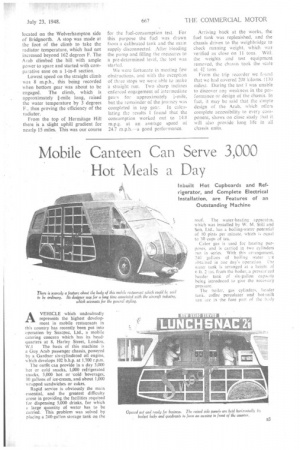Mobile Canteen Can Serve 3,000 Hot Meals a Day
Page 37

Page 38

If you've noticed an error in this article please click here to report it so we can fix it.
Inbuilt Hot Cupboards and Refrigerator, and Complete Electrical Installation, are Features of an Outstanding Machine AVEHICLE which undoubtedly represents the highest development in mobile restaurants M this country has recently been put into operation by Snacpac, Ltd., a mobile catering concern which has its headquarters at 8, Harley Street, London, W. I The basis of this machine is a Guy Arab passenger chassis, powered by a Gardner six-c.ylindered oil engine, \k hich develops 102 b.h.p. at 1,700 r.p.m.
The outfit can provide in a day 3,000 hot or cold snacks, 1,000 refrigerated snacks, 5,000 hot or 'coldbeverages, 30 cations of ice-cream, and about 1,000 wrapped sandwiches or cakes.
Rapid service is obviously the main essential, and the greatest difficulty arose in providing the facilities required for dispensing 5,000 drinks, for which a large quantity of water has to be carried. This problem was solved by placing a 240-gallon storage tank on the roof. The water-heating apparatus, which was installed by W. M. Still and Son. Ltd., has a boiling-water potential of tO pints per minute. which is equal to 10 cups of tea.
Calor gas is used for heating purposes, and is carried in two cylinders run in series. With this arrangement, 240 gallons of boiling water tie obta.ned in one day's operation. I he water tank is arranged at a height of 6 ft. 2 ins, from the boiler, a pressarered header tank of six-gallon capacity being introduced to cive the necessary pressure.
The boiler, gas cylinders, header tank, coffee percolator and hot-milk urn are in the fore part of the hotly on th.e. near side, and all drain pipes, steam escape and vent pipes are connected at the rear of the vehicle. Burned gases are carried up through the roof into a wind-controlled vent which acts as an extractor, whether the
vehicle be moving or stationary. The water tank „is insulated to keep the contents at an even temperature.
Tea is made in three-gallon thermalinsulated percolators and tea servors, which deliver fresh tea for each customer; the rate of delivery is seven pints per minute. All tea is served in Mono beakers, which are used only once. No fewer than 8,000 of these beakers are stored on the vehicle.
Midway along the length of the machine is the counter, on which is mounted the soda-fountain, and further to the rear there is an automatic gramophone and public-announcement installation. Beyond .these, again, comes the wash basin, beneath which is a sanitary tank of 16-gallon capacity.
6-kW Generator Plant
At the forward end of the vehicle is a 6-kW generator plant powered by a converted Austin 7 h.p. engine. The output is 240 volts d.c., and the maximum consumption, with all switches "on," is 4/ kW. The interior is quite devoid of fumes when the unit is running at full output. This equipment weighs 6 cwt. and is rubber-insulated on a detachable trestle attached directly to the frame of the vehicle, so that there is no vibration.
On the off side of the vehicle there are four 600-watt hot cupboards, a refrigerator and an ice-cream con servator. Designed and built by the General Electric Co., Ltd., each cupboard can accommodate 750 packed meals, the arrangement. of the doors being such that removal of any particular meal-box does not cause the whole interior to become cool. The refrigerator, which is of 25 cubic ft. capacity, will hold 1,000 cold snacks. It is mounted on six layers of Fiberglass enclosed in Alclad.
At the rear of the vehicle, also on the off side, there is a large storage clipboard, the lower portion of which provides thecrew with separate locker accommodation. The upper portion is for the storage of tea, sugar and food containers. There is further cupboard space in the roof at the rear of the water tank.
Interior lighting consists of two 150watt lamps, one at each end of the counter. The floodlights installed are used only when there is no street or other form of exterior illumination.
When the generator is not running, lighting is obtained from the I2-volt system on the vehicle, in conjunction with three 24-watt barrel-type lights, and two 48-watt ceiling lights mounted over the gangway. The power for the automatic gramophone is obtained from the vehicle batteries, the current being taken through a rotary converter to supply a.c. current at 240 volts. The loud-speaker is positioned behind a rainproof grille built into the near side of the vehicle at the rear. Immediately to the left of the serving counter there is a cash register.
Fully loaded, the vehicle weighs approximately 10-1 tons. Overall, it is 27 ft. 6 ins. long, 7 ft. 6 ins, wide and 12 ft. high to the top of the mast. It was designed by Mr. John W. Pagan. of Snacpac, Ltd. The body, based on a steel cantilever designed to deal with the great top load of water, was built by D. I. Hawkins and Sons, Ltd., of Reading.




















































































